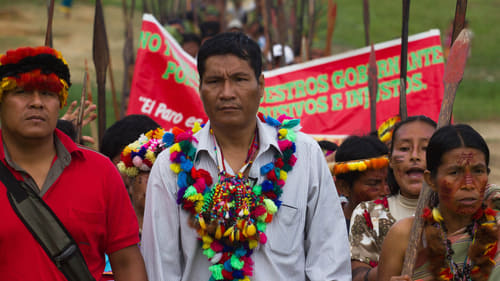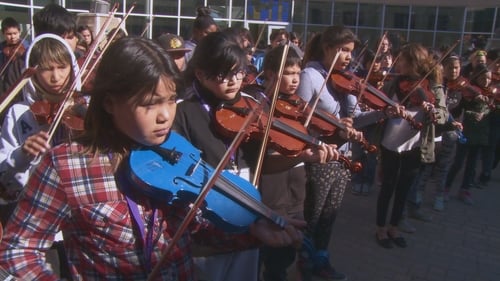Habilito: Debt for Life (2010)
Жанр : документальный
Время выполнения : 51М
Директор : Chuck Sturtevant, Daniela Ricco Quiroga
Краткое содержание
Documents the conflicts and tensions that arise between highland migrants and Mosetenes, members of an indigenous community in the Bolivian Amazon. It focuses particularly on a system of debt peonage known locally as ‘habilito’. This system is used throughout the Bolivian lowlands, and much of the rest of the Amazon basin, to secure labor in remote areas.

Искатель приключений отправляется вместе с друзьями в амазонские джунгли в поисках затерянного индейского племени и экзотических впечатлений. Однако проводник исчезает, а друзья теряют друг друга. Йосси остается в джунглях один на несколько недель, и ему приходится бороться за выживание в условиях дикой природы. В джунглях узнаешь, кто ты на самом деле. Учишься побеждать страх, боль и отчаяние, чтобы выжить.

Река, протекающая сквозь густые джунгли, несет замученного иезуитского священника, привязанного к грубо сколоченному кресту. Распятие проносится через скалистые стремнины и в один момент, полный ужаса и завораживающей красоты, обрушивается вниз с 70-метровой высоты и исчезает в рокочущем водопаде. Этой сценой открывается один из самых зрелищных фильмов в истории кино, о человеке со шпагой и человеке в капюшоне, объединившихся, чтобы защитить индейское племя от колониальных империй 18-го века…

Место действия фильма — бразильские джунгли. Племя индейцев похищает пятилетнего мальчика, в то время как его отец, американский инженер, занят строительством дамбы. В течение десяти лет отец ищет сына, и после многочисленных приключений, полных экзотики, они встречаются в дебрях Амазонки.

Ослепительная красавица Серена выходит замуж за успешного промышленника Джорджа Пембертона. Счастливая пара правит лесозаготовительной империей Пембертонов, и кажется, что нет ничего и никого, кто мог бы встать на пути их полного нежности и страсти брака. Но тайны прошлого и ревность опасны как стихия.

В индейской резервации Ред Кроу начали оживать мёртвые: выпотрошенная рыба, пристреленная из жалости собака. Зараза не обошла стороной и людей, которые, превратившись в безмозглых агрессивных тварей, стали бросаться на здоровое население. Но у коренных жителей Америки обнаружился иммунитет к неизвестному вирусу. Теперь они вынуждены жить на ещё меньшей огороженной территории и всеми силами противостоять зомби-чуме, ведь даже при устойчивости к этому страшному заболеванию быть съеденным заживо — то ещё удовольствие.

После завоевания и разграбления испанцами государства Инков возникла легенда о сказочно богатой стране Эльдорадо, которая затерялась в бесчисленных болотах бассейна Амазонки.

Основанная на реальных событиях, драматическая история любви разыгрывается под величественной сенью грозного вулкана на острове Танна, который принадлежит крошечному тихоокеанскому государству Вануату.

История взаимоотношений между Карамакате, амазонским шаманом, последним выжившим представителем своего народа, и двумя учеными, которые на протяжении 40 лет вместе ищут на Амазонке священное целебное растение.

Этот документальный фильм рассказывает об общинах национальных меньшинств в Новой Шотландии и их борьбе с властями из-за опасного воздействия промышленных отходов.

In this tense and immersive tour de force, audiences are taken directly into the line of fire between powerful, opposing Peruvian leaders who will stop at nothing to keep their respective goals intact. On the one side is President Alan Garcia, who, eager to enter the world stage, begins aggressively extracting oil, minerals, and gas from untouched indigenous Amazonian land. He is quickly met with fierce opposition from indigenous leader Alberto Pizango, whose impassioned speeches against Garcia’s destructive actions prove a powerful rallying cry to throngs of his supporters. When Garcia continues to ignore their pleas, a tense war of words erupts into deadly violence.

Three Alaska Native women work to save their endangered language, Kodiak Alutiiq, and ensure the future of their culture while confronting their personal demons. With just 41 fluent Native speakers remaining, mostly Elders, some estimate their language could die out within ten years. The small community travels to a remote Island, where a language immersion experiment unfolds with the remaining fluent Elders. Young camper Sadie, an at-risk 13 year old learner and budding Alutiiq dancer, is inspired and gains strength through her work with the teachers. Yet PTSD and politics loom large as the elders, teachers, and students try to continue the difficult task of language revitalization over the next five years.

For ancient Mayans, cocoa was as good as gold. For subsistence farmer Eladio Pop, his cocoa crops are the only riches he has to support his wife and 15 children. As he wields his machete with ease, slicing a path to his cocoa trees, the small jungle plot he cultivates in southern Belize remains pristine and wild. His dreams for his children to inherit the land and the traditions of their Mayan ancestors present a familiar challenge. The kids feel their father's philosophies don't fit into a global economy, so they're charting their own course. Rohan Fernando's direction tenderly displays a generational shift, causalities of progress in modern times and a man valiantly protecting an endangered culture. Breathtaking vistas of lush rainforests contrast with the urban dystopia that pulled Pops children away from him. Will one child return to carry on a waning way of life

Plant Explorer Richard Evans Schultes was a real life Indiana Jones whose discoveries of hallucinogenic plants laid the foundation for the psychedelic sixties. Now in this two hour History Channel TV Special, his former student Wade Davis, follows in his footsteps to experience the discoveries that Schultes brought to the western world. Shot around the planet, from Canada to the Amazon, we experience rarely seen native hallucinogenic ceremonies and find out the true events leading up to the Psychedelic Sixties. Featuring author/adventurer Wade Davis ("Serpent and the Rainbow"), Dr. Andrew Weil, the Grateful Dead's Bob Weir and many others, this program tells the story of the discovery of peyote, magic mushrooms and beyond: one man's little known quest to classify the Plants of the Gods. Richard Evans Schultes revolutionized science and spawned another revolution he never imagined.

In this era of “reconciliation”, Indigenous land is still being taken at gunpoint. INVASION is a new film about the Unist’ot’en Camp, Gidimt’en checkpoint and the larger Wet’suwet’en Nation standing up to the Canadian government and corporations who continue colonial violence against Indigenous people. The Unist’ot’en Camp has been a beacon of resistance for nearly 10 years. It is a healing space for Indigenous people and settlers alike, and an active example of decolonization. The violence, environmental destruction, and disregard for human rights following TC Energy (formerly TransCanada) / Coastal GasLink’s interim injunction has been devastating to bear, but this fight is far from over.

The territory of Akwesasne straddles the Canada-U.S. border. When Canadian authorities prohibited the duty-free cross-border passage of personal purchases - a right established by the Jay Treaty of 1794 - Kanien'kéhaka protesters blocked the international bridge between Ontario and New York State.

Legendary documentary filmmaker Alanis Obomsawin provides a glimpse of what action-driven decolonization looks like in Norway House, one of Manitoba's largest First Nation communities.

CREE CODE TALKER reveals the role of Canadian Cree code talker Charles 'Checker' Tomkins during the Second World War. Digging deep into the US archives it depicts the true story of Charles' involvement with the US Air Force and the development of the code talkers communication system, which was used to transmit crucial military communications, using the Cree language as a vital secret weapon in combat.

The AssimiNation is a political pamphlet portraying the indigenous Sámi people fighting for their existence. The film follows the on going cultural genocide of the Sámi which the current Governmental politics allow. This film is a cry for help for the last indigenous people living in the EU.

In this follow-up to his 2003 film, Totem: the Return of the G'psgolox Pole, filmmaker Gil Cardinal documents the events of the final journey of the G'psgolox Pole as it returns home to Kitamaat and the Haisla people, from where it went missing in 1929.

Herlinda Augustin is a Shipibo healer who lives with her family in Peruvian Amazonia. Will she and other healers be able to maintain their ancient tradition despite Western encroachment?















